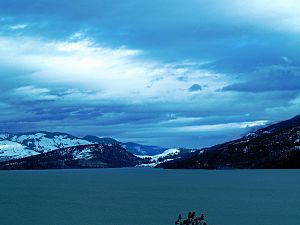Kalamalka Lake facts for kids
Quick facts for kids Kalamalka Lake |
|
|---|---|
 |
|
| Location | Southern Central British Columbia |
| Coordinates | 50°10′25″N 119°19′48″W / 50.17361°N 119.33000°W |
| Lake type | Glacial Lake |
| Primary inflows | Coldstream Creek, Vernon Creek, Oyama Creek |
| Primary outflows | Vernon Creek |
| Basin countries | Canada |
| Max. length | 16 km (52,000 ft) |
| Max. width | 3 km (9,800 ft) |
| Surface area | 25.7 km2 (9.9 sq mi) |
| Average depth | 58.5 m (192 ft) |
| Max. depth | 142 m (466 ft) |
| Water volume | 1.5 km3 (0.36 cu mi) |
| Residence time | 55.2 years |
| Shore length1 | 42.4 km (26.3 mi) (approx.) |
| Surface elevation | 392 m (1,286 ft) |
| Settlements | Coldstream, Lake Country |
| 1 Shore length is not a well-defined measure. | |
Kalamalka Lake, also known as "Kal Lake", is a large lake in the middle of southern British Columbia, Canada. It is located east of Okanagan Lake. The lake is about 4 kilometres (2.5 mi) south of the city of Vernon. It provides most of Vernon's drinking water.
The lake gets its name from an Okanagan First Nation chief. He lived along the northern shores of the lake.
One of the coolest things about Kalamalka Lake is its amazing colors. At different times of the year, the water can change from bright blue-green to deep purple. Sometimes, you can even see different colors in different parts of the lake at the same time! This is why it's often called the "lake of a thousand colors." The colors come from tiny bits of calcium carbonate (a natural mineral) in the water. These tiny bits reflect light in special ways.
What Makes the Water Special?
Kalamalka Lake is a unique type of lake. Its water has low levels of nutrients, which means it's very clear. The lake also mixes its water from top to bottom once a year, usually in the fall and winter.
During warmer months, from May to early November, the lake water forms layers. The top layer gets warm, and the deeper water stays cold. As tiny water plants (called phytoplankton) grow more in the sun, they cause minerals like calcium and carbonate to form tiny particles. These particles make the water cloudy and give the lake its famous changing colors. You might even see white mineral deposits on plants near the shore.
How Water Flows In and Out
The main source of water for Kalamalka Lake comes from Wood Lake. Wood Lake is located to the south and is connected by a canal at Oyama.
Water leaves Kalamalka Lake from its northern end through Vernon Creek. This creek then flows through the city of Vernon and eventually into Okanagan Lake.
Fun Things to Do at Kalamalka Lake
Kalamalka Lake is a popular spot for outdoor fun. It has many beautiful beaches where people can relax and swim. Some of the well-known beaches include Kal Beach, Cosens Bay Beach, Jade Bay Beach, and Kekuli Bay Beach. Kaloya Regional Park Beach is located at the south end of the lake.
There are also two provincial parks along the lake's shores. Kalamalka Lake Provincial Park and Protected Area is a large park covering about 4,209 hectares. Kekuli Bay Provincial Park is smaller, at 57 hectares. These parks offer great places for hiking and enjoying nature.
Many people visit Kalamalka Lake for boating and water skiing. It's a great place to enjoy water sports. While there isn't much fishing pressure on the lake, it's a perfect spot for other water activities. Tween Lakes Resort is one of the places you can stay, and it has the only fuel dock on the lake for boats.



